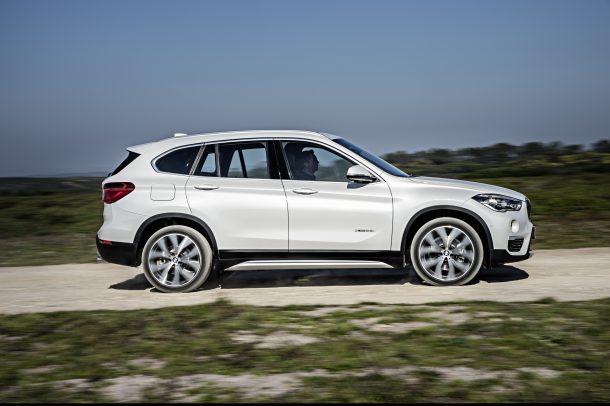SUV Popularity Isn't Exclusive to North America; Crossovers Are Now 25 Percent of Europe's Market

Europe always seemed like a safe haven for the sort of car lover who turns up their nose over North America’s obsession with the sport utility vehicle. That’s now changing, as European demand for SUVs and crossovers continued to grow in 2016. While it may have a penchance for slightly smaller models, the EU saw disproportionately high sales of compact crossovers last year.
In total, SUV sales accounted for 25 percent of all European passenger vehicle sales in 2016 — up from 21 percent the previous year. That doesn’t quite equal the United States’ fervent addiction but, if the European Union keeps this pace, it’ll be less than a decade before it closes the gap.
The strongest-selling examples listed by Automotive News Europe include the Volvo XC60, Renault Captur, Nissan Qashqai, or BMW X1, and might look microscopic when compared to a Chevrolet Suburban, but those models make up a big part of of the equation. Those vehicles outpaced the overall market increase of 6.5 percent by a huge margin, as did most SUVs that weren’t of a gargantuan nature.
Of course, those sales increases came at the expense of sedans, hatchbacks, and especially wagons — echoing the North American market trend away from small, practical passenger cars.
Europe’s smallest SUV segment grew 20 percent to 1.26 million units last year while traditional subcompacts, led by the Renault Clio and Volkswagen Polo hatchbacks, lost ground. The same was true for compact crossovers, which performed even better and ate into Golf sales.
Larger SUVs were a mixed bag, however. While premium options saw a 22 percent sales increase to 271,014 units last year, more common examples actually declined by 12 percent — resulting in a mere 70,473 European deliveries for 2016.
Europe’s quickest-growing segment was its premium compact crossover category. Smaller and more lavish SUVs saw a 40 percent gain to 338,428 units. The biggest contributor to that figure was the BMW X1, which doubled its own sales sales to 97,218.
[Image: BMW]

A staunch consumer advocate tracking industry trends and regulation. Before joining TTAC, Matt spent a decade working for marketing and research firms based in NYC. Clients included several of the world’s largest automakers, global tire brands, and aftermarket part suppliers. Dissatisfied with the corporate world and resentful of having to wear suits everyday, he pivoted to writing about cars. Since then, that man has become an ardent supporter of the right-to-repair movement, been interviewed on the auto industry by national radio broadcasts, driven more rental cars than anyone ever should, participated in amateur rallying events, and received the requisite minimum training as sanctioned by the SCCA. Handy with a wrench, Matt grew up surrounded by Detroit auto workers and managed to get a pizza delivery job before he was legally eligible. He later found himself driving box trucks through Manhattan, guaranteeing future sympathy for actual truckers. He continues to conduct research pertaining to the automotive sector as an independent contractor and has since moved back to his native Michigan, closer to where the cars are born. A contrarian, Matt claims to prefer understeer — stating that front and all-wheel drive vehicles cater best to his driving style.
More by Matt Posky
Latest Car Reviews
Read moreLatest Product Reviews
Read moreRecent Comments
- Dartman https://apnews.com/article/artificial-intelligence-fighter-jets-air-force-6a1100c96a73ca9b7f41cbd6a2753fdaAutonymous/Ai is here now. The question is implementation and acceptance.
- FreedMike If Dodge were smart - and I don't think they are - they'd spend their money refreshing and reworking the Durango (which I think is entering model year 3,221), versus going down the same "stuff 'em full of motor and give 'em cool new paint options" path. That's the approach they used with the Charger and Challenger, and both those models are dead. The Durango is still a strong product in a strong market; why not keep it fresher?
- Bill Wade I was driving a new Subaru a few weeks ago on I-10 near Tucson and it suddenly decided to slam on the brakes from a tumbleweed blowing across the highway. I just about had a heart attack while it nearly threw my mom through the windshield and dumped our grocery bags all over the place. It seems like a bad idea to me, the tech isn't ready.
- FreedMike I don't get the business case for these plug-in hybrid Jeep off roaders. They're a LOT more expensive (almost fourteen grand for the four-door Wrangler) and still get lousy MPG. They're certainly quick, but the last thing the Wrangler - one of the most obtuse-handling vehicles you can buy - needs is MOOOAAAARRRR POWER. In my neck of the woods, where off-road vehicles are big, the only 4Xe models I see of the wrangler wear fleet (rental) plates. What's the point? Wrangler sales have taken a massive plunge the last few years - why doesn't Jeep focus on affordability and value versus tech that only a very small part of its' buyer base would appreciate?
- Bill Wade I think about my dealer who was clueless about uConnect updates and still can't fix station presets disappearing and the manufacturers want me to trust them and their dealers to address any self driving concerns when they can't fix a simple radio?Right.


































Comments
Join the conversation
Et tu, Europe?
As the MK3 Jetta is the nemesis of Mr. Regular, any and all crossovers are my nemesis. A scourge upon the automotive market, they are. An unwelcome compromise. IDGAF, IWNGAF about ease of ingress/egress as it's sold. Not worth the wack trade off of fuel economy and ponderous driving dynamic.